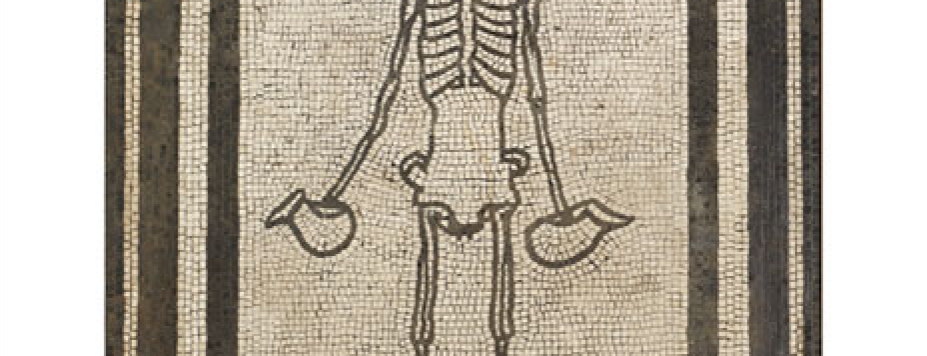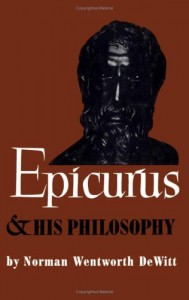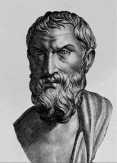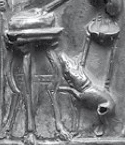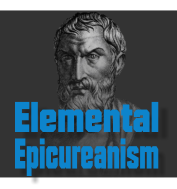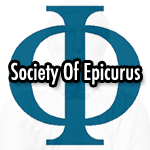This page is devoted to collecting images of art from the ancient world which appear to have Epicurean themes. Please email suggestions for inclusion in this list.
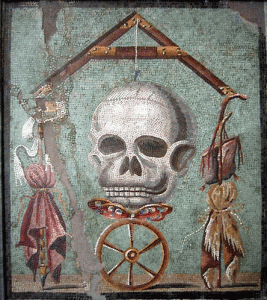 |
MEDITATE MORTEM: Meditate on death.**The mosaic to the left is identified by the National Archaelogical Museum of Naples as being found in Pompeii in the “House cum workshop, I, 5, 2, triclinium,” and is estimated as dating from between 30 BC to 14 AD. The museum inscription reads in part: “This emblem was displayed in a triclinium and is one of the most striking for the clarity of its allegorical representation. … The composition is surmounted by a level with a plumb line, the instrument used by masons to get their constructions straight and level. Below are … death (the skull) below which are a butterfly (the soul) and a wheel (fortune). On each side, suspended from the arms of the level and kept in perfect balance … are the symbols of wealth and power on the left (the sceptre and purple) and poverty on the right (the beggar’s scrip and stick). The theme, like the skeletons on the silverware in the treasure of Boscoreale, was intended to remind diners of the fleeting nature of earthly fortunes.”The house where the mosaic was found is identified as belonging to Marcus Vesonius Primus, and photos may be seen at PompeeiinPictures. Interestingly, from the political inscriptions outside his house, Marcus Vesonius seems to have been actively involved in politics, and this might be added to the example of Cassius as supporting the view that Epicurean Romans were not averse to participating in public life. From Pompeii: its life and art By August Mau, Francis Willey Kelsey: “To judge from the election notices painted on the front of the fullery and on the houses at either side Primus must have taken an active interest in local politics. He was an ardent partisan as witness this inscription Cn Helvium aed drp for acdi lem dignum re publica Vesonius Primus rogat Vesonius Primus urges the election of Gnaeus Helvius as aedile a man worthy of public office The endorsement of Gavins Rufus is even stronger: (C G avium Rufum II vir ovf utilem rp duumvirnm oro vos facite utilem rei publicae Vesonius Primus rogato) — Vesonius Primus requests the election of Gaius Gavius Rufus as duumvir a man serviceable to public interests do elect him I beg of you. In one of the shorter recommendations Primus names his occupation (L Ceium Secundum II vid Primus fullo rogat) Primus the fuller asks the election of Lucius Ceius Secundus as duumvir with judiciary authority. On one occasion he united with his employees in favoring a candidate for the aedileship (Cn Helvium Sabinum aed Primus cum suis facit) Primus and his household are working for the election of Gnaeus Helvius Sabinus as aedile..
The same book continues on: The garden on which the colonnade opened contains an open air triclinium. The table was ornamented with a mosaic top now in the Naples Museum with a characteristic design. … Among the following passages that this image might have evoked in the minds of those familiar with Lucretius are the following:
** from Seneca’s Letter XXVI to Lucilius |
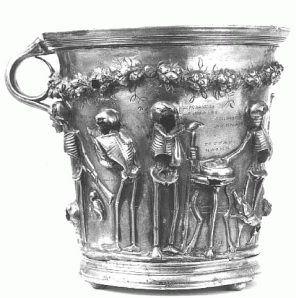 |
BOSCOREALE CUP:Among the descriptions on the internet is the following:The Boscoreale treasure included this cup which reputedly has Epicurean maxims engraved along with the skeletons. A Latin inscription on the base of one of the cups gives their weight and the name of their owner, Gavia. Greek inscriptions engraved in dots form captions, and are accompanied by Epicurean maxims such as: “Enjoy life while you can, for tomorrow is uncertain.” Clotho, one of the Fates, looks on as Menander, Euripides, Archilochus, Monimus the Cynic, Demetrius of Phalera, Sophocles, and Moschion provide a caustic and ironic illustration of the fragility and vanity of the human condition. But the main message of the cups’ decoration is that life should be enjoyed to the full: Zeno and Epicurus, the founders of the Stoic and Epicurean philosophies in the 4th century BC, confront each other before two mating dogs—a detail of some significance, as it represents the triumph of Epicureanism.
|
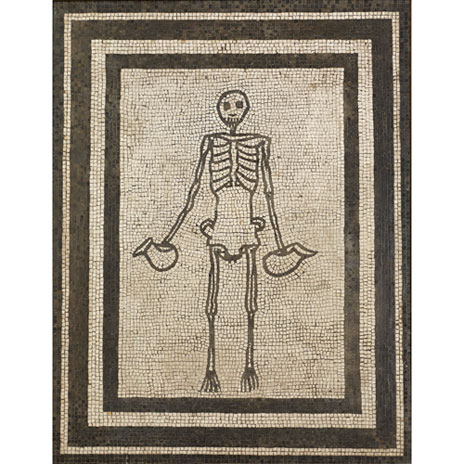 |
Photos of this mosaic from Pompeii can be purchased from the British Museum |




